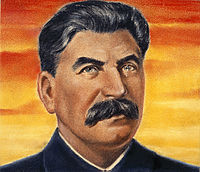|
Vikidia currently has 4,621 articles. Improve it! |
|
Join Vikidia: create your account now and improve it! |
Joseph Stalin
Joseph Stalin (real name Iosif Vissarionovich Djougachvili; 18 December 1878 – 5 March 1953) was the general secretary of the CPSU from 1922 until his death in 1953.[1] Stalin was leader of the Soviet Union from 1924 until 1953, though he attempted to resign in 1927.[2] His industrialization programs built up the Soviet Union into an industrial superpower, however certain programs, such as mandatory farm collectivization, worsened the Soviet Famine of 1932-33. His form of government was later be referred by some historians as Stalinism. Stalin invaded Poland on 18 September 1939. In the subsequent World War II, Stalin stayed neutral but signed a non-aggression pact with Germany's leader Adolf Hitler, after Britain refused to sign a treaty in which the Soviets would have sent one million troops to the German border in order to deter German aggression.[3] He then fought a bloody war after Germany invaded the Soviet Union. The end of the war saw Marxist-Leninist governments take power in all Eastern Europe except Greece, strengthening the Soviet Union's status as a superpower.
World War II[edit | edit source]
Stalin signed a non-aggression pact with Nazi Germany after Britain refused to join an anti-fascist pact against Germany, the treaty that the Soviets signed with Germany also split Poland between Germany and the USSR.
But later on, in 1941, Adolf Hitler turned against Stalin and attacked the Soviet Union, trying to conquer it and enslave the Soviet people. After this happened, the USSR began working with the Allies to defeat Germany. In the end, Germany lost, but the USSR had more casualties than any other country during the war.
When the World War II was over, the Soviet army ended up occupying many countries in Europe, such as Poland, Czechoslovakia, Hungary, and part of Germany, establishing Marxist-Leninist governments in those countries.
Stalin continued to rule over the Soviet Union until he died, though it has been claimed he attempted to resign in 1952.[4] Stalin also militarized the USSR by focusing the country's time and energy towards weapons, vehicles, and the armed forces.
Stalin died on March 5, 1953. It was officially said to be because of a stroke. In 2003, however, a group of Russian and American historians said that they believed Stalin had been poisoned with warfarin, possibly by the men who took over the government after Stalin died.[5] Led by Lavrentiy Beria, these were Nikita Khrushchev and Georgi Malenkov. The three of them began a process called "De-Stalinization", which meant taking apart much of the political system that Stalin made. Stalin was denounced as a tyrant, however, after outsmarting and defeating his rivals, Krushchev established control over the Soviet government, until he was removed in 1964 by members of the CPSU's Central Committee, and detained by the KGB in an airport in Moscow.
Sources[edit | edit source]
- The initial version of this article on Vikidia was a copy of the article Joseph Stalin on the Simple English Wikipedia.
References[edit | edit source]
- ↑ http://www.pbs.org/redfiles/bios/all_bio_joseph_stalin.htm |title=Biography: Joseph Stalin |work=pbs.org |accessdate=03 October 2014
- ↑ https://www.marxists.org/reference/archive/stalin/works/1927/10/23.htm#1
- ↑ https://www.telegraph.co.uk/news/worldnews/europe/russia/3223834/Stalin-planned-to-send-a-million-troops-to-stop-Hitler-if-Britain-and-France-agreed-pact.html
- ↑ http://www.stalinsociety.org/2016/04/05/stalin-tries-to-resign-unpublished-speech-by-stalin-at-the-plenum-of-the-central-committee-of-the-cpsu-1952/
- ↑ "Secret documents reveal Stalin was poisoned". PRAVDA.Ru. 29 December 2005. http://english.pravda.ru/history/29-12-2005/9457-stalin-0/.

|
History Portal — All articles about history. |
